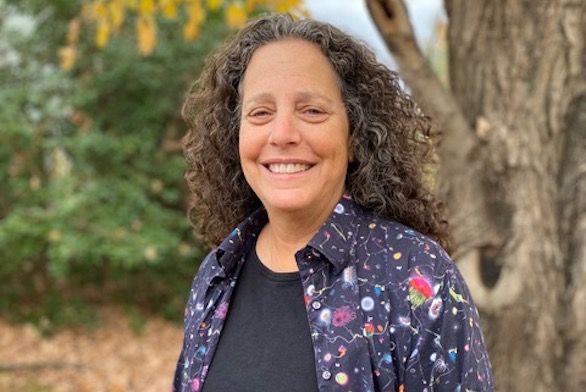Asking the Big Questions in a Neuroscience Preceptorial
December 4, 2019 | By Eve Tolpa

“A really natural fit for the philosophical mind.”
That’s how Leslie Kay (SF83) characterizes neuroscience, the subject on which she’s currently leading a preceptorial with tutor Phil Bartok at the St. John’s Santa Fe campus.
Kay is on sabbatical from the University of Chicago, where she is a professor in the Department of Psychology and directs her lab at the Institute for Mind and Body. Her research focuses on olfactory perception in rats—or, as she puts it, “how the different parts of the olfactory systems interact with each other [to] accomplish smelling.”
When that focus is widened, Kay says, it entails “understanding how brains create meaning in a sensory world.” Olfactory research is more or less analogous to research of other human senses, because at the heart of the inquiry lie questions about the nature of the mind itself: How do you end up with a sense of self? How do we think there is continuity in the world?
These are questions that will sound familiar to any serious student of the liberal arts—and indeed, many scientifically inclined Johnnies go on to study neuroscience in graduate school.
“I think for St. John’s students it’s a really natural scientific next step, because—as far as we know—the brain is a major player in sort of creating the self, the mind,” says Kay. “It has a record of previous experience, in effect creating meaning.”
While some of her University of Chicago courses tend to entail straight presentation of subject material, the approach she is taking for the St. John’s preceptorial is different. Like other Program courses, it introduces students to original texts and engages them in a process of discovery.
“Here we’re reading the seminal papers to understand the steps of reasoning that led scientists to their conclusions,” Kay says. “We’re learning along the way and appreciating the outcomes of debates,” discerning “how to think about neuroscience in a really rigorous and agnostic way.”
Though the 13 preceptorial students start the semester with philosophical readings from Descartes and Hume, the majority of their course material is from the 20th century, when most of the seminal foundational work in the field occurred.
Kay says that reading texts from the likes of Adrian, Eccles, Ramon y Cajal, and Golgi, as well as behaviorists such as Pavlov and Skinner, “gives the students a foundation in the basics of neuroscience.” From there, they can apply critical thinking skills to the subject’s big questions: Are neurons connected networks or individual entities? Do neurons communicate chemically or electrically? Is information processing an appropriate way to think about what brains do?
These queries do not just represent thought exercises for students; instead, they are the questions posed by working neuroscientists. “The really important questions have no answer,” Kay says. “Really good questions have a lot of nuance, so asking those questions allows you to understand the complexity in the systems. There is lots of room to explore these issues in earnest, just as professional scientists do.”
But, she emphasizes, “first you have to study the little questions—understand how electrodes work, the nuts and bolts.” It is often necessary to slow down to ensure that students grasp the material, which can be “difficult,” she admits. “Asking the big questions without understanding the material, sometimes you go in circles.”
For Kay, part of the strength of a St. John’s education—for both herself and her students—is the quality of “not being attracted to being right but being attracted to finding the truth. It makes the mind better at science. Biology is complicated. It doesn’t give you the satisfaction where you can prove things right. You can only prove things wrong. It’s a very messy, complex field. I find that very exciting.”
She is equally excited by the “culture of fearlessness” she witnesses every day at St. John’s. “It’s a total joy to teach these students. Together we learn so much. I learn from them as much as they learn from me.”

